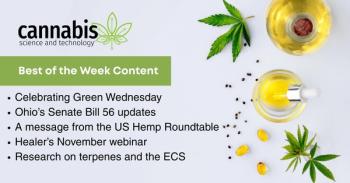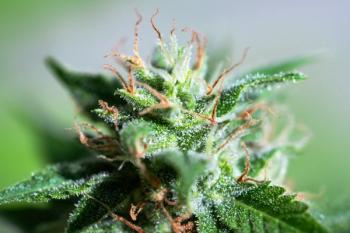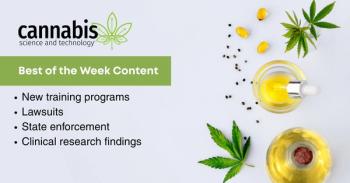
Advancing Chromatography Methods for Cannabis Analysis

The cannabis industry has been taking a hard look at the science behind their products and the various contaminants that can inadvertently be added to consumer goods. As testing laboratories begin to implement new state-mandated regulations and other consensus methods for best practices, there is a need to review the analytical instruments and methods that can deliver the most accurate results in a timely fashion. Anthony Macherone, senior scientist at Agilent Technologies and visiting scientist at the Johns Hopkins University School of Medicine, recently spoke to us about his research in this area and the chromatographic techniques he’s found to be most effective for profiling cannabinoids and terpenes, detecting pesticides, and residual solvents testing.
You recently published an article about the use of liquid chromatography–time-of-flight mass spectrometry (LC–TOF-MS) for cannabinoid profiling and quantitation in hemp oil extracts (1). Can you tell us about the method development involved in this project? How does the LC–TOF-MS method improve upon previous methods used to analyze hemp oil extracts?
The purpose of the project was to demonstrate a semi-targeted method to profile cannabinoids in hemp oil, quantitate a targeted list of cannabinoids in the samples, and to begin the development of a spectral library that can be used for annotation of cannabinoids found in unknown samples.
An Agilent-developed high performance liquid chromatography–ultraviolet (HPLC–UV) method used for potency testing provided the foundational LC parameters for method development. For example, a smaller injection volume, a slightly different mobile phase gradient, and a narrower column internal diameter with a 1.8-µm particle size were used in the LC–TOF-MS method. We also took advantage of a quaternary pump to maintain a constant percentage of aqueous modifiers (ammonium formate and formic acid) over the analytical run time. The quaternary pump helped to maintain a flat baseline across the chromatogram, and reduce methanol degradation, which is known to occur when buffers are added directly to the organic mobile phase.
In most laboratories providing safety and compliance testing for cannabis and cannabinoid products, HPLC with UV detection (230 nm) provides a stable, robust, and relatively fast platform for day-to-day productivity work. In the United States and Canada, 4–6 cannabinoids are required to be quantitated by regulation. These include â9-tetrahydrocannabinol (THC), its carboxylated analogue THCA, cannabidiol (CBD), its carboxylated analogue CBDA, cannabinol (CBN), and cannabigerol (CBG). Many laboratories will also quantitate 5–8 more cannabinoids in their assay, but they are not required to do so by the regulatory authorities. However, when using HPLC with UV detection, a laboratory runs the risk of misidentifying an interfering compound, such as a terpene for a cannabinoid. There are two factors that mitigate this risk:
- sample preparation for cannabinoid analyses includes very high dilution factors (1000-fold to as much as 2000-fold), and
- many terpenes, which can be present in the 1–2% range by weight, poorly absorb at a wavelength of 230 nm. Even so, small terpene peaks are often seen in HPLC–UV assays.
To differentiate cannabinoids from other endogenous compounds, and identify as many as 120–140 different cannabinoids in a given genetic strain, LC–TOF-MS leverages high-resolution accurate mass (HRAM) spectrometry. HRAM mitigates matrix and endogenous chemical interferences, and facilitates identification of chemical components through high-precision mass assignment and formula generation. Of course, HRAM is not perfect. If a chemical component with the same accurate mass (empirical formula) is eluted at the same time as a cannabinoid, it cannot differentiate between the two, but this type of coelution is generally a rare occurrence. Nonetheless, to ensure lot-by-lot quality control, LC–TOF-MS can provide a wealth of information about a given strain. Moreover, drug discovery and development labs researching cannabinoids or modified cannabinoid scaffolds use LC–TOF-MS for metabolic identification and drug metabolism and pharmacokinetics (DMPK) studies.
What other cannabis applications have you used LC methods for?
LC–triple quadrupole mass spectrometry (LC–TQMS) is primarily used for targeted residual pesticides quantitation, as well as for mycotoxin and ochratoxin quantification in cannabis and cannabinoid products.
A big issue in cannabis is how each state where it is legalized has their own testing requirements. You recently addressed this topic in an application note (2), where you used LC–MS/MS and gas chromatography (GC)–MS/MS techniques. Can you describe that research? What sample preparation challenges were faced in this study?
Agilent collaborated with Pacific Agricultural Lab in Oregon to develop a simplified sample preparation workflow that could be shunted to both LC–TQMS and GC–TQMS platforms for comprehensive pesticide residue analysis of more than 210 common pesticides-far more than any U.S. state or country requires. In this way, unsanctioned pesticides can be identified, as well as pesticides that are approved for use through regulation. Again, this approach is not perfect because it is a targeted MS/MS method, and only defined compounds will be identified and quantitated. If a grower applies an unsanctioned pesticide, not on the target list, it will not be found. Here again, is an opportunity for LC–TOF-MS and GC–TOF-MS to screen for large numbers of pesticides in an untargeted mode, then samples determined to be positive for a pesticide or pesticides, can be analyzed by LC–TQMS or GC–TQMS for confirmation and quantitation.
The issue with this TOF screening approach is sensitivity-many pesticides will be present in parts-per-billion (ng/mL) concentrations. TOF-MS sacrifices sensitivity for HRAM, and is generally not as sensitive as triple-quadrupole mass spectrometry. However, in the described sample preparation method, the final dilution factor for both LC–TQMS and GC–TQMS is 500-fold. In this way, the very high sensitivity of these instruments is leveraged, and common problems such as constant GC inlet and column maintenance, carryover, and clogging of HPLC columns are mitigated. This sample preparation approach may open the door for TOF screening applications. For example, a 100-fold dilution factor may provide the sensitivity enhancement needed to detect low levels of pesticides in cannabis and cannabinoid samples.
When developing screening methods for pesticides, do you keep in mind the various states’ lists of pesticides?
Absolutely. We have U.S. state-specific collaborations, and often tailor our methodology for a given U.S. state’s or Canada’s list of pesticides. We also keep in mind that there are many compounds on both the California and the Canadian lists that are not well-suited for electrospray ionization (ESI) or atmospheric pressure chemical ionization (APCI). In fact, 25 pesticides found on at least nine U.S. state lists are recommended for analysis by GC–TQMS by AOAC International. Therefore, forward thinking laboratories and those laboratories in U.S. states such as California, are aware that to provide accurate and robust testing data to their client, they will need both LC–TQMS and GC–TQMS platforms.
What other cannabis applications have you used GC methods for? Do you see potential for more GC applications in the future?
GC-specific methods for cannabis quality and compliance testing include terpene profiling and quantitation for cannabis flower and cannabinoid products. Residual solvents testing is also often required especially for manufactured cannabinoid isolates such as oils, butters, and edible products. Although chemical detection can be performed with flame ionization detection (FID), we advocate simultaneous FID and mass spectrometry detection with a single-quadrupole mass spectrometer. In that way, the large dynamic concentration range of these compounds can be quantified via FID and speciated via single-quadrupole MS. Moreover, to ease sample preparation and create a clean matrix for analyses, headspace auto-sampling should be included in these methods.
What is the biggest analytical science issue to tackle in cannabis?
A valid concern is adulteration of dispensed marijuana, or hemp oil products with illicit chemicals such as synthetic cannabinoids, bath salts (cathinones), or other illegal designer drugs. U.S. state and Canadian regulations only include targeted lists of regulated compounds, and like the example for pesticides given above, if some growers adulterate their crop with a dangerous chemical that is not on the targeted list, it will not be detected, and that product may be released for distribution. Unsanctioned pesticides are often found in marijuana crops, but only by those that look for them. In a similar fashion, laboratories need to develop screening methods to identify adulterants in cannabis products before they reach the retail dispensaries.
What are the next steps in your cannabis research?
We continue to identify gaps in the industry’s analytical needs. One area of interest to me is the development of TOF-based applications for true comprehensive screening, and to support targeted confirmation and quantification on other analytical platforms.
References:
- A. Macherone, J. Stevens, M. Adams, A. Roth, K. Kaikaris, S. D’Antonio, and R. Steed, “Advancing the Analysis of Medical Cannabis,” supplement to LCGC North Am. and Spectroscopy, 23–26 (2017).
- L. Asanuma, D. Miller, R. Jordan, M. Churley, and A. Macherone, “A Novel Comprehensive Strategy for Residual Pesticide Analysis in Cannabis Flower,” Agilent Application Note (2018).
Newsletter
Unlock the latest breakthroughs in cannabis science—subscribe now to get expert insights, research, and industry updates delivered to your inbox.





